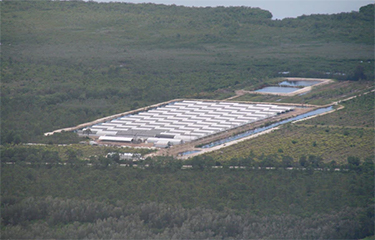US RAS shrimp farms still “boutique,” but innovations leading to greater production

Recirculating aquaculture system (RAS) production of shrimp in the U.S. is a small portion of the market, but innovations in the industry will lead to future growth, according to
McIntosh addressed the future of land-based shrimp farming in the U.S. during the National Fisheries Institute Global Seafood Market Conference – which ran from 15 to 19 January in La Quinta, California, U.S.A.. Charoen Pokphand is developing its own RAS shrimp operation, Homegrown Shrimp, in the U.S. state of Florida, joining a number of companies across the country making forays into the budding industry.
McIntosh said most current oprators are still largely “boutique” thanks to low production numbers, resulting in higher costs.
“It’s a premium market. We cannot sell at an import price,” he said.
Market prices for a kilogram of shrimp produced via RAS can be as high as USD 50.00 (EUR 46.02), according to McIntosh, prices which companies need to hit to counter the high cost of production.
Part of that high cost is related to how new the RAS shrimp industry is - so new, in fact, that best practices for the most-efficient and successful method of farming shrimp haven’t been nailed down yet.
“There are two types of RAS. One is clear water that’s more familiar with [use in] fish RAS, and in shrimp we have a lot of times we have recirculating, or what we call floc, where you’re doing the water treatment in the tank – which is what we will do,” McIntosh said. “You’ve got both choices for shrimp, and it’s to be determined which one will succeed in the end, because at this point there’s nobody in the United States that I would say is succeeding. This is all very new.”
Early problems for RAS shrimp, he said, include countering the high mortality that a lot of systems have initially.
“When I first started looking at RAS in the United States and in Europe, the shrimp all died,” McIntosh said. “You couldn’t have efficiency, because you would end up with 20 percent survival. It gets to about 50 days, 60 days, and they just start dying.”
Despite a lack of major shrimp diseases in the U.S., the high stress of being raised in an RAS would lead to shrimp mortality, McIntosh said.
There are multiple ways to solve the problem, McIntosh said. Homegrown Shrimp found developing shrimp that got to harvest size faster to essentially “outrun death" was its best approach.
“That’s basically the strategy we have,” he said. “When you’re growing fast shrimp though, you’re feeding a lot more per unit of time.”
That higher feed rate can lead to its own problems, which add to other issues the industry already has – such as equipment needing to be adjusted from its typical use in finfish RAS systems.
For now, McIntosh said, the industry is really at its early stages. Total production in the U.S. amounts to only 350 metric tons of shrimp a year, but he predicted that number will increase in the next few years as innovation continues to accelerate.
“I think that as we implement some more successes, we’ll get it up to 1,000 tons in the next couple of years,” McIntosh said.
Photo courtesy of Sun Shrimp






Share